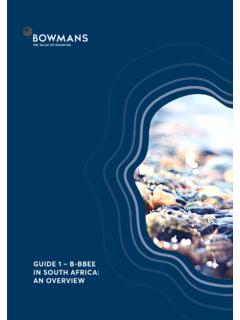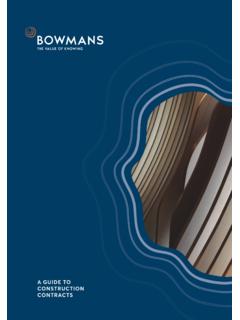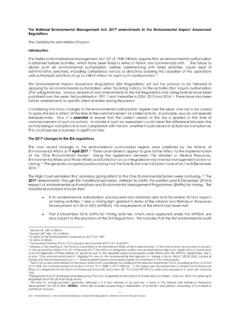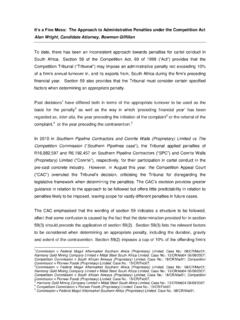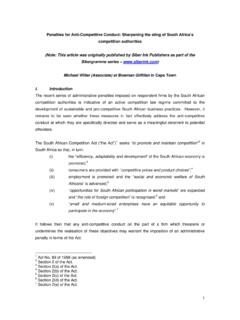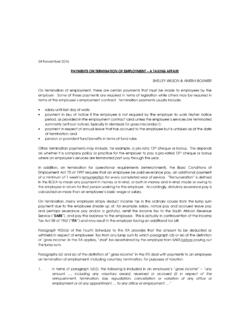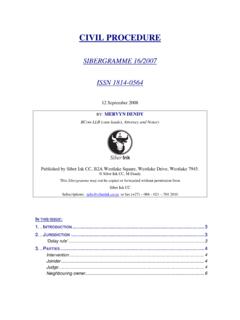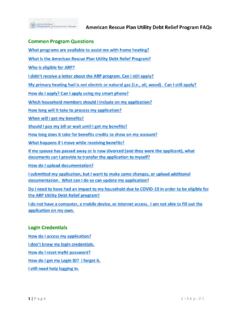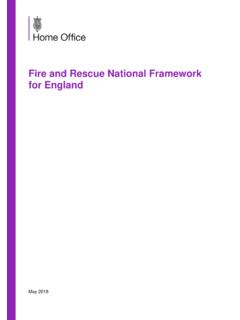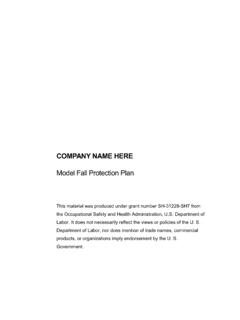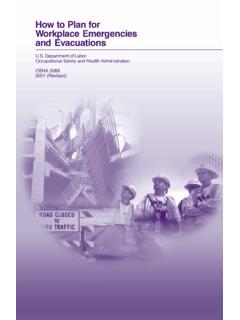Transcription of Liquidation Business Rescue and Compromise in South Africa
1 GUIDE - Liquidation , Business Rescue AND Compromise IN South AFRICABOWMANSBOWMANS206 THE Liquidation PROCESS12 Business Rescue PROCEEDINGS 20 COMPROMISES UNDER THE COMPANIES ACT22 INFORMAL RESTRUCTURING24 OUR FIRM25 OUR FOOTPRINT IN AFRICA26 KEY CONTACTSC ontents3 Guide - Liquidation , Business Rescue and Compromise in South Africa ForewordThis guide provides an introduction to the three formal processes available to distressed companies in South Africa - Liquidation , Business Rescue and compromises under the Companies Act 71 of 2008 (Companies Act).It has been prepared by a team of our lawyers who specialise in these areas of law. In addition, it is worth noting that informal restructuring processes are increasingly common. We hope you find it useful. For further information or specific assistance, please do not hesitate to contact any one of the key contacts included at the end of this de HuttonPartner The contents of this guide are for reference only and should not be considered to be a substitute for detailed legal advice.
2 It is correct as at October - Liquidation , Business Rescue and Compromise in South Africa 5 BOWMANSTHE Liquidation PROCESS6 The Liquidation ProcessUnder the current law in South Africa the winding-up of solvent and insolvent companies is regulated by different legislation. The winding-up of solvent companies is governed by the Companies Act, while the winding-up of insolvent companies is governed by the Insolvency Act 24 of 1936 (Insolvency Act) and the Companies Act 61 of 1973 (Old Companies Act). This guide deals with the winding-up of insolvent companies. Liquidation or winding-up is a relatively simple process that involves the realisation of a company s assets either by way of private treaty or by way of public auction in order to pay the costs and expenses incurred in the winding-up process.
3 Funds remaining after costs and expenses are paid, are distributed to creditors in their prescribed order of preference and according to the creditors rights and interests in the company. The test for placing a company in Liquidation , in short, is that it cannot pay its debts as they fall due. A company may be liquidated either voluntarily, by means of the board of directors passing a resolution to that effect, or an application can be made to court either by the company itself (a shareholders resolution is required) or by a creditor or shareholder of the company. In most instances a court application is brought either by the company or a creditor on the basis that the company is unable to pay its debts as they fall due. The application is made on affidavit under oath in the court having jurisdiction in the area where the company has its registered practice differs from division to division ( in different parts of the country), but in many instances the practice is that initially application is made for a provisional order of winding-up and on the return day, which is usually some six weeks after the grant of the provisional order, application is made for a final order of winding-up.
4 Prior to the date of the hearing of the application the applicant must ensure that a copy of the application for Liquidation is furnished to: the company; the employees of the company; any registered trade union representing the employees of the company; and the South African Revenue Services (SARS).Proof of having done so must be provided to the court either before or during the hearing of the a court grants a winding-up order, the commencement of the winding-up is backdated to the time that the application for winding-up was presented to the court (approximately the date upon which papers were first filed at court). Where Liquidation commences by way of resolution, winding-up commences when the resolution is registered with the Companies and Intellectual Property Commission (CIPC) established under the Companies Act.
5 Once a provisional order of winding-up is granted, the provisional order must be delivered by the sheriff of the court to the same parties referred to above (employees, trade unions, SARS). In addition, the court will usually order that a copy of the provisional order be published in both an English and Afrikaans newspaper in the area. The court may also order that a copy of the order be sent to all known creditors. Guide - Liquidation , Business Rescue and Compromise in South Africa 7 The Master of the High Court (Master) will appoint provisional liquidators. The Master appoints liquidators based on creditor support. A previously disadvantaged individual is also likely to be appointed as an additional liquidator. As soon as possible after the final winding-up order is granted, the Master will summon a meeting of creditors in order for creditors to, inter alia, lodge their claims, and nominate final liquidators.
6 The first meeting usually takes place within six to eight weeks of final Liquidation . Notice of the meeting is published in the Government Gazette. The Master may oblige the liquidators to give notice of the meeting to creditors. Creditors have a further opportunity to prove claims at a second meeting, which must be held within three months of the liquidators final appointment (which appointment usually takes place shortly after the first meeting). Creditors may usually also prove claims at later special meetings of creditors, if necessary. Claims are supported by affidavits under oath and must include all necessary supporting documentation. Only creditors who submit claims can benefit from a distribution of funds. The role of the liquidator is to administer and wind-down the company s affairs. The liquidator must realise (sell) all assets and distribute the proceeds to creditors in their order of preference (see Ranking of creditors in a Liquidation below).
7 The entire process usually takes between six months and two years, depending on the complexity of the company and the number and nature of assets to be realised. If the liquidators embark on litigation, this process can extend for a number of years. Once a company is placed in Liquidation it ceases to trade unless continued trading is necessary in the best interests of all creditors ( because the liquidators want to sell the Business as a going concern or because certain contracts need to be continued with in order to generate funds for creditors). Continued trading must be sanctioned either by the court or by creditors and shareholders. The liquidators must lodge a first Liquidation and distribution account (account) within six months of the date of their appointment as final liquidators. If the assets (if any) have all been realised and there are no unresolved issues, it could be a first and final account.
8 If it is not a final account, the liquidator must submit an account every six months until the winding-up process is complete. The liquidator may apply for extensions of time in appropriate circumstances. The accounts sets out the details of all funds received by the liquidator from the realisation of assets, all expenses incurred and how the funds are to be distributed. Once the Master approves an account ( the Master is satisfied that it appears correct), he or she will give the liquidators permission to advertise that the account will lie open for inspection. It must lie open for inspection for a period of not less than 14 days. During this period creditors may inspect the account and lodge objections. Assuming that there are no objections, the Master will usually confirm the account within a few days of the expiry of the advertising liquidator must give notice of the confirmation of the account by the Master in the Government Gazette.
9 BOWMANS8 Once the account is confirmed, the liquidator will distribute any funds that may be available for distribution. If a contribution is required by a creditor (because the assets were insufficient to cover the basic costs of the Liquidation ), it becomes payable. When the affairs of the company have been completely wound-up, the Master transmits a certificate to this effect to CIPC and a copy to the liquidator. The CIPC records the dissolution of the company and publishes a notice to this effect in the Government of creditors in a Liquidation There are three distinct types of creditors: Secured creditors are creditors holding security for their claims in the form of a special mortgage, landlord s hypothec, pledge or right of retention. They rank first and are paid from the proceeds of the sale of the secured asset.
10 All of the types of security (other than general notarial bonds where the mortgagee has not taken possession of the property subject to the bond) will, if validly created, constitute the holder of the security interest as a secured creditor in relation to the secured asset. No special priority applies among the secured creditors, as each secured creditor has a secured claim in respect of a particular asset. To the extent that creditors have security over the same asset, the creditor granted security earlier in time usually has a higher-ranking claim in respect of that asset. Where a secured creditor s claim is not satisfied in full, the unpaid balance is considered a concurrent claim. Guide - Liquidation , Business Rescue and Compromise in South Africa 9 Preferent creditors are creditors who do not hold specific security for their claims, but rank above concurrent creditors.
